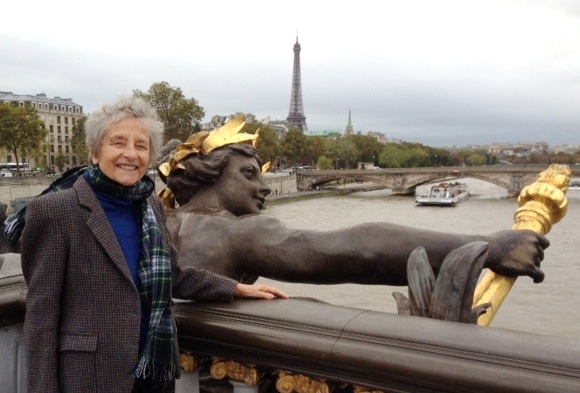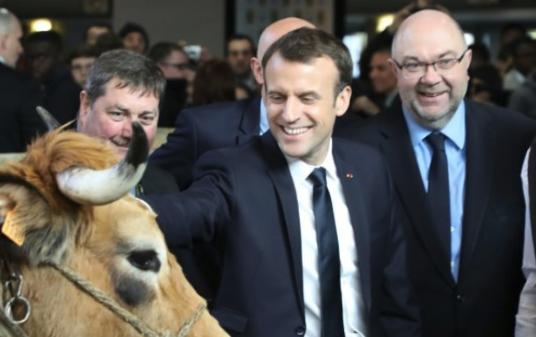
The Salon de l’Agriculture (agricultural fair) is the most popular event of the year in Paris. For two weeks, the Porte de Versailles is turned into an oversize farm Four thousand animals – bovines, pigs, sheep and fowl – move in for the delight of both children and adults. It is the largest agricultural show in Europe.
The French are emotional about their relationship with the countryside and never forget that they share a common rural ancestry and that, just a few decades ago, 25 percent of the population lived and worked on the land. The fair is an opportunity for rural and urban communities to get together and have a good time.
Food is a big attraction at the fair. Thirty seven restaurants offer culinary specialties from each region: trip à la mode de Caen (tripe cooked in cider and calvados), boeuf bourguignon, tartiflette (Savoyard gratin with Reblochon cheese, cream and pork), Toulouse cassoulet , bouillabaisse and hundreds more dishes, accompanied by the best wines.

Entertainment reaches its height with the competition for the best animal. This year the star of the show is Haute, a 700 kilo blonde cow of the Aubrac breed raised in Aveyron (a volcanic plateau in the south west), whose big black eyes are made-up with mascara. Haute has a pedigree in the same way as a racehorse and her offspring are already in line to compete in the 2024 fair – the same year that the Olympics will be held in Paris.
From the air, the French landscape looks like a beautiful tapestry with colored patches of fields, woods and clusters of roofs huddled around a church steeple. Behind this idyllic picture, it is hard to believe that there is a tough world of fierce competition, hard work, and for some, a struggle to survive .
Among the 450,606 working farms in France to-day, many of them are small with less than 10 hectares (one hectare is equivalent to 2.47 acres.) Their owners find it hard to make a living. The average income of a farmer is 1,525 euros for month and can be as low as 500 euros, which is well below the poverty threshold. There are many reasons for this.
Food today represents only 20 percent of a family budget as compared to 34.7 percent in 1960. The agri-business and chains of supermarket distributors, in order to increase their profit margin, force the farmers to sell their milk or meat at rock-bottom prices.
Farmers are deep in debt because of the necessity to invest but they have ways to show their anger and frustration, such as pouring manure or truck loads of raw eggs on public squares. Another effective way is for them to launch an operation escargot (snail offensive.) They bring their five-mile an hour tractors on the highways with the expected result.
European farmers could not survive without financial subsidies from Brussels. In 1962, the Politique d’Agriculture Commune (PAC — Common Agricultural Policy) was set up by the European Union (EU) to assist and guide the agriculture of its members. The PAC is the second largest item in the EU budget and one of its pillars. Methods and objectives have changed over the years.
For a while, it requested farmers to lay fallow their cultivated land. Quotas for milk were stopped in 2015 and sugar in 2017. Today the PAC is putting more emphasis on the development of organic food and protection of farmers against the climatic vagaries. France is the leading agricultural country in Europe with production valued at 71 billion ahead of Germany (56.7 billion), Italy (54.2 billion) and Spain (49 billion.) France remains the top beneficiary of financial assistance from the PAC.
Most Europeans are hostile to the use of pesticides. Brussels wanted to set a 10-year-moratorium on the use of the herbicide Glyphosate. Macron fought and demanded three years. Finally Brussels decided on a period of five years.
In France, Monsanto has become the prime bad guy. Europeans are also against genetically-modified food and the addition of hormones and antibiotics in meat. The French are getting very finicky about the traceability of products A couple of years ago, horse meat was found in prepared food produced in Eastern Europe. The French public went up in arms. Since then, on every package or can, the geographic origin of the product has to be indicated.
Macron, during his visit to the Agricultural Fair asked the crowd, “Did you know that that 70 percent of the meat you eat in French restaurants is imported? It makes no sense when French meat is probably the best in the world.” The president is not a protectionist but, in his eyes, free trade agreements have to be equally beneficial for both sides. At present, the signing of the Mercosur Treaty between Europe and four South American countries is stalled, leaving Europeans worried.
It is a “must” for each French president to visit the fair. Macron outdid all his predecessors by mingling with the crowd for more than 12 straight hours. Always eager to explain his policies, he did not hesitate to plunge into the fray and engage in heated discussions with angry farmers.
The day before the opening of the Salon, Macron had invited 700 young farmers to the Elysees palace. As always, his method was not to promise financial assistance, but help his guests find creative solutions to make their farms more competitive.
Editor’s Note: This is the opinion of Nicole Prévost Logan.

Nicole Prévost Logan
About the author: Nicole Prévost Logan divides her time between Essex and Paris, spending summers in the former and winters in the latter. She writes a regular column for us from her Paris home where her topics will include politics, economy, social unrest — mostly in France — but also in other European countries. She also covers a variety of art exhibits and the performing arts in Europe. Logan is the author of ‘Forever on the Road: A Franco-American Family’s Thirty Years in the Foreign Service,’ an autobiography of her life as the wife of an overseas diplomat, who lived in 10 foreign countries on three continents. Her experiences during her foreign service life included being in Lebanon when civil war erupted, excavating a medieval city in Moscow and spending a week under house arrest in Guinea.